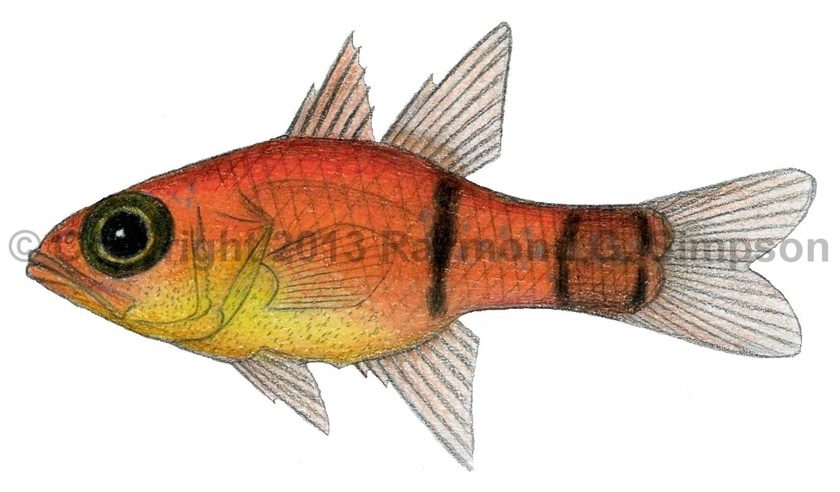
Common Name
Belted Cardinalfish
Year Described
Breder, 1927
Identification
Dorsal Fin: VI, I-9
Anal Fin: II, 8
Pelvic Fin: I, 5
Pectoral Fin: 12
Gill Rakers: 16-18 lower
Vertebrae: 10 precaudal, 14-15 caudal
A small fish with a fairly robust and moderately compressed body. Eye is large and the snout short. Mouth is fairly large and oblique, with the lower jaw slightly protruding. Both jaws, palatine, and vomer with narrow bands of villiform teeth (no canines). Preopercular edge with a heavily serrate margin. Preopercular flap does not extend past the preopercular rear margin. There are two dorsal fins. The caudal fin is forked. Body scales ctenoid. Predorsal scales 6. Scales around the caudal peduncle 12.
Color
Body pale pink to red, often with scattered opalescent blue spots and yellow speckles on the lower head and body. A thin black bar runs from the second dorsal fin to the anal fin. A thick bar on the caudal peduncle varies from all dark to pale with dark anterior and posterior edges, giving the appearance of two thin caudal bars in some fish. Fins pale pink.
Size
Maximum size to 65mm SL.
Habitat
Coral and rocky reefs from 3-55m. Found in caves and under overhangs.
Range
S. Florida to N. South America, including the Gulf of Mexico and the Caribbean Sea. Also Bermuda.
References
Gon, O. 2002. Apogonidae (pp 1386-1391). In: Carpenter. 2002. The living marine resources of the Western Central Atlantic. Vol. 3: Bony fishes part 2 (Opistognathidae to Molidae), sea turtles and sea mammals. FAO Species Identification Guides for Fisheries Purposes. American Society of Ichthyologists and Herpetologists Special Publication No. 5.
McEachran, J.D. & J.D. Fechhelm. 2005. Fishes of the Gulf of Mexico. Volume 2: Scorpaeniformes to Tetraodontiformes. University of Texas Press, Austin. i-viii +1-1004.